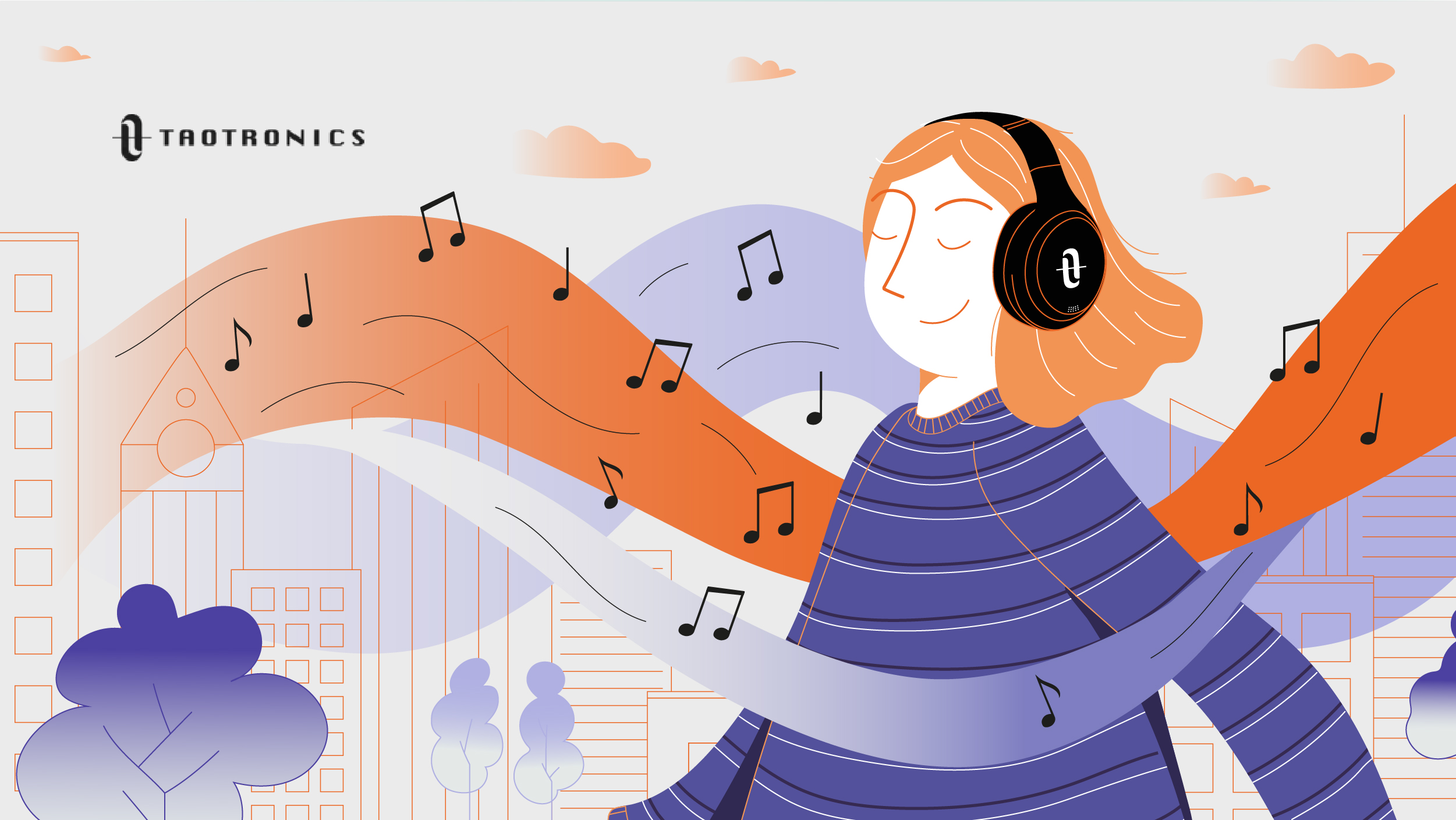Happy New Year from TaoTronics! In this blog, we don’t just explain what headphones soundstage is—we tell you how to conduct a soundstage headphones test and other practical advice. Scroll to learn more!
Picture this. You’ve got your tickets. Worn your nicest clothes, a dark navy color you save for special occasions. After lining up in the cold at the entrance to the theater, you’ve found your seat, made yourself comfortable in the velvet-lined chair, then closed your eyes, ready for the orchestra to begin their show. Ten minutes in and you’re listening to each section as part of the beautiful chorus. String, woodwind, percussion, and bass are clearly defined.
Now picture this. You sit down in your front room with a fresh mug of coffee, wearing your favorite pajamas. You put your headphones on, close your eyes, and press play on your phone. You select some orchestral music and wait for the music to swell. Listening on the best soundstage earbuds, you hear each section, hear each instrument—it’s almost as if you’re at the theater, even if that isn’t quite allowed yet with lockdown rules.
This is your audio soundstage. The better it is, the more immersive it is.
And it doesn’t just work for an orchestra—heavy metal, dubstep, drum and bass: You name it, the music genre sounds better when your headphones have a good audio soundstage. This blog covers everything you need to know, but if you aren’t interested in learning more about an audio soundstage then you can skip to the end of this blog to learn about TaoTronic’s headphones, including the best soundstage headphones for gaming.
What is an Audio Soundstage in Headphones?
So, we’ve got you to picture an audio soundstage. But, for anyone who isn’t an audiophile, what is it exactly?
Officially, a soundstage is the area that a movie studio uses to record sound to use in films (mostly dialogue, voice overs, that sort of thing). When it comes to headphones, this changes. Instead of being a physical space, the area is imagined—a sort of 3D stage in your mind that is filled with your music, where you can hear the different instruments individually amongst the song. How clear that visualization is depends on the quality of your headphones. For instance, if they are high-fidelity, your audio soundstage will be a lot better and it will be easier to visualize your music.
Why is A Soundstage Important?

A good audio soundstage is important when you are wearing headphones because it helps you to become immersed in your music.
- Each studio creates visual stages for each mix of music, and each genre of music. To get the full audio experience, you need a better soundstage that will allow you to fully visualize the music.
- You can hear a different version of the same song when you listen with a better audio soundstage. Nothing changes, but you can hear instruments that before blended into the background noise.
- It’s more fun! Especially nowadays, when it’s difficult to get to concerts. The more you can recreate that experience at home, the better!
Headphone Imaging vs. Sound Stage: What is the Difference?
Another word you might have heard of is headphone imaging. If you haven’t, it’s a term you don’t need to know, but it’s useful to understand.
In general, you should know that imaging refers to the positional accuracy of a sound within the soundstage. That is, where the sound seems as if it’s coming from. It’s hard to notice this in headphones, and it’s a term more commonly applied to speakers and sound systems. You can try hearing it for yourself if you are an audiophile. Can you hear one particular instrument as you listen, and where does it sound like it is based in the soundstage?
If your imaging is off, it can cause listening fatigue, because your brain isn’t used to listening to sounds in this way. It needs to work extra hard to understand and localize the noise.
The difference between the two, then, is as follows:
Sound Stage
Elements of a soundstage aren’t reproduced; they are created. They aren’t integral to the audio itself, though they make the listening experience better.
Crosstalk
This is needed to make sure you receive soundwaves into each ear, from each headphone or earbud.
Early Reflections
When soundwaves are emitted from speakers or sound systems, they bounce off different objects before reaching your eardrum. This action is known as an “early reflection,” and can alter the way your brain interprets the sound. A slight change in the wave can help you interpret the type of space you are in, and the dimensions of wherever you are. Kind of like bats, with echolocation!
When you are wearing headphones or earbuds, your music isn’t affected by these early reflections. You get no indication of the space you are in because the soundwaves are sent straight into your ears.
Distance & Angle of the Source
When you are listening to music without headphones, the music is—usually—in front of you (think of a concert or watching TV). You—usually—position your head so that you are facing the music at all times, because it makes it easier to hear.
This is different with headphones. They’re sending music directly into your ear, and this can work at whatever angle you place your head. This means that the sound stage is far closer to your head. The type of headphones you wear can alter the proximity of the soundstage, i.e. how close or far away the audio sounds. A wider sound stage means that the audio sounds further away from your ears.
Imaging
This represents how accurate the positioning is of sounds in the soundstage; the greater the accuracy, the more localized it is, and the easier it is for your brain to understand the audio. If you are using headphones or earbuds, there is greater accuracy with a smaller audio soundstage. When you choose earphones with a wide soundstage, the accuracy might be off as a wide audio soundstage is harder to achieve with headphones.
Headphones Soundstage Comparison

The type of soundstage you hear will alter depending on the type of headphone that you buy. We have already talked about the different types of headphone that are available to you, but here’s a quick overview:
If you want headphones you can use at work or sports headphones, get in-ear cans with an open-back design and passive noise-cancelling technology. Over-ear headphones offer great bass performance while on-ear headphones balance quality sound and portability. But if you prefer to block out the world, get closed-back, over-ear headphones with active noise-cancelling technology.
So, from this we can gather that closed back headphones are going to have a better soundstage than open back. Over ear headphones with noise cancelling technology also sound like they will give you a better ability to hear your audio.
What happens if you want a wide soundstage, or want to use in-ear devices (earphones or earbuds) instead of over-ear devices (headphones)? We explore this below.
Closed Back Headphones (with good soundstage)
Often, music fans think of closed back headphones with good soundstage as having heavy bass. This isn’t always the case, but you are more likely to hear the individual music sections compared to wearing open back headphones. The latter pair favor a “natural” sound and you can hear more of the outside world when you listen.
Because of their heightened noise cancellation abilities, closed back headphones offer a more crisp and clear sound than open back headphones. This means that, although they have a reputation for being bass-heavy, the best models are great for playing medium frequency music as well.
Open Back Headphones (with wide soundstage)
If you’re looking for the best soundstage headphones for gaming, look no further. Improved audio—particularly with games you love to play around Halloween—mean that you need the best audio devices to get the full gaming experience. You miss out on a lot if you can’t hear when something is creeping up on you. Or, if you want to just listen to the best tunes on FIFA.
Open back headphones with wide soundstage help you to hear every last change in audio. Mark Cerny, the guy behind the PS5, has said the best way to experience this console’s incredible 3D audio is to wear headphones, while SONY have admitted that TV virtual surround sound won’t be ready by launch day.
Open back headphones are liked because they give you an “authentic” sound; this makes it wider and purer than closed back. There is nothing blocking you from hearing the outside world, so it feels more naturally like you’re in a concert space (or, immersed in your gaming world).
Earphones (with wide soundstage)
While it’s more difficult to find earphones or earbuds with a wide soundstage, it’s by no means impossible. Pairs with hi-fi, high clarity audio can deliver an impressive soundstage, sometimes feeling as amazing as over-ear headphones. However, this isn’t always the case, and you can’t expect a pair of cheaper earbuds to carry the same quality audio as well-built over-ear cans.
Ultimately, you need to decide.
Do you want a more natural listening experience, usually coveted by audiophiles and gamers? Or, is noise cancellation the way forward for you? If you’re using your headphones for day-to-day activities (e.g. exercising, commuting etc.) we would recommend closed back headphones for the best, most defined audio soundstage experience.
How to Test Your Headphone Soundstage
One really fun way to test the soundstage and imaging of your headphones (or any speakers) is to watch the above video. It’s only quick (under a minute long), but it is an interesting way to see judge the width of your soundstage. It will also test your brain a little as you realize just how these systems work!
How to Do the Test
- Make sure your headphones are connected via AUX cable or Bluetooth to whichever device will play the video.
- Play the video and listen carefully.
- Be in awe! …if you aren’t, your headphones might not have the best audio soundstage. Time for an upgrade!
If you want to learn in-depth about audio soundstage and headphone imaging, check out this video below:
TaoTronics Bluetooth Headphone Soundstage
At TaoTronics, we know that audio soundstage matters. Our headphones are built for people who appreciate good music to become immersed in their music every day. That’s why our over-ear headphones are closed back, with hi-fi quality audio and large headphone drivers to deliver great audio, from heavy bass, to medium frequencies.
We also use incredible noise cancelling technology, so that you can get lost in your music and feel ready to start your day, concentrate, workout, or whatever you’ve got going on that means you need your headphones.
Our headphones deliver a consistently great audio soundstage with great battery life and even better looks. What are you waiting for? Check out our website today.
Conclusion: Good Soundstage Matters
Ultimately, you need to decide: Do I want a more natural soundstage experience, or do I want the best hi-fi audio I can get? We’re not saying you can’t have both, but, if you’ve read this blog, you’ll know that there are serious differences between what different types of headphone have to offer in terms of audio soundstage. Whether you’re looking for the best soundstage headphones for gaming or you’re eying up some earbuds, it’s useful to know that the type of headphone you buy, and whether it is open or closed back, will make a huge difference to your listening experience. Remember, you can always do a soundstage headphones test to judge the quality of your headphones’ audio!
Head to the TaoTronics website today to check out headphones with amazing noise cancellation and hi-fi audio that are ideal for commuting, gaming, and everything in between!

- Celebrate Labor Day: Discounts from TaoTronics - April 23, 2021
- How to Connect Bluetooth Headphones to Your Macbook Pro or iMac - April 9, 2021
- Headphone Earpads Full Guide: Replacements, Covers, and more! - March 26, 2021
